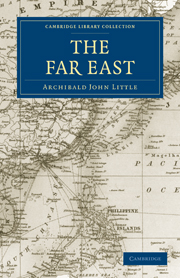Book contents
- Frontmatter
- PREFACE
- EDITORIAL NOTE
- Contents
- LIST OF MAPS AND ILLUSTRATIONS
- CHAPTER I DEFINITION
- CHAPTER II THE CENTRAL KINGDOM: CHINA
- CHAPTER III THE NORTHERN BASIN. THE YELLOW RIVER
- CHAPTER IV THE MIDDLE BASIN: PART I. THE YANGTSE RIVER
- CHAPTER V THE MIDDLE BASIN: PART II. THE PROVINCE OF SZECHUAN
- CHAPTER VI THE MIDDLE BASIN: PART III. THE CHENGTU PLATEAU
- CHAPTER VII THE MIDDLE BASIN: PART IV. THE LOWER YANGTSE PROVINCES
- CHAPTER VIII THE INTERMEDIATE PROVINCES
- CHAPTER IX THE SOUTHERN BASIN. YUNNAN TO CANTON
- CHAPTER X THE DEPENDENCIES: PART I. MANCHURIA
- CHAPTER XI THE DEPENDENCIES: PART II. MONGOLIA
- CHAPTER XII THE DEPENDENCIES: PART III. TURKESTAN
- CHAPTER XIII THE DEPENDENCIES: PART IV. TIBET
- CHAPTER XIV WHILOM DEPENDENCIES: PART I. INDO-CHINA
- CHAPTER XV WHILOM DEPENDENCIES: PART II. COREA
- CHAPTER XVI THE BUFFER KINGDOM: SIAM
- CHAPTER XVII THE ISLAND EMPIRE: JAPAN
- INDEX
- Plate section
CHAPTER XVI - THE BUFFER KINGDOM: SIAM
Published online by Cambridge University Press: 05 October 2010
- Frontmatter
- PREFACE
- EDITORIAL NOTE
- Contents
- LIST OF MAPS AND ILLUSTRATIONS
- CHAPTER I DEFINITION
- CHAPTER II THE CENTRAL KINGDOM: CHINA
- CHAPTER III THE NORTHERN BASIN. THE YELLOW RIVER
- CHAPTER IV THE MIDDLE BASIN: PART I. THE YANGTSE RIVER
- CHAPTER V THE MIDDLE BASIN: PART II. THE PROVINCE OF SZECHUAN
- CHAPTER VI THE MIDDLE BASIN: PART III. THE CHENGTU PLATEAU
- CHAPTER VII THE MIDDLE BASIN: PART IV. THE LOWER YANGTSE PROVINCES
- CHAPTER VIII THE INTERMEDIATE PROVINCES
- CHAPTER IX THE SOUTHERN BASIN. YUNNAN TO CANTON
- CHAPTER X THE DEPENDENCIES: PART I. MANCHURIA
- CHAPTER XI THE DEPENDENCIES: PART II. MONGOLIA
- CHAPTER XII THE DEPENDENCIES: PART III. TURKESTAN
- CHAPTER XIII THE DEPENDENCIES: PART IV. TIBET
- CHAPTER XIV WHILOM DEPENDENCIES: PART I. INDO-CHINA
- CHAPTER XV WHILOM DEPENDENCIES: PART II. COREA
- CHAPTER XVI THE BUFFER KINGDOM: SIAM
- CHAPTER XVII THE ISLAND EMPIRE: JAPAN
- INDEX
- Plate section
Summary
Siam, the last of the continental countries on our list, whose frontier until recently marched with that of China, and whose people are one in which the Mongol type of the inhabitants of the countries hitherto described fades off into that of the Hindu-Malayan races to its west and south, forms the outermost extension of the wide region abutting on the China Sea and that has Chinese civilization as its base, in contradistinction to the races of Aryan or Iranian type that people the western half of the Eurasian continent, in which civilization developed simultaneously but independently from the early Graeco-Phenician inhabitants of the shores of the Mediterranean. The contrast in mental type and consequent modes in which the phenomena of mind and matter are regarded by the Mongol and the Aryan, is as marked as is that of their physical conformation; the typical distinctive feature of which, in the Mongol, is the bridgeless nose with wide flattened nostrils, the prominent cheekbones and retreating forehead, contrasting with the aquiline nose and dome-shaped forehead of the Aryan. Holding this main distinction in view, the Malays, like the Japanese, must be classed with the Mongol division of humanity, to which, likewise, the Shans and Siamese undoubtedly belong, although a certain admixture of Aryan and Hindu blood is apparent among them, which may account for their greater receptivity of western ideas and less subservience to that Chinese philosophical teaching, which has been at once the glory and the bane of the neighbouring nations.
- Type
- Chapter
- Information
- The Far East , pp. 258 - 278Publisher: Cambridge University PressPrint publication year: 2010First published in: 1905



